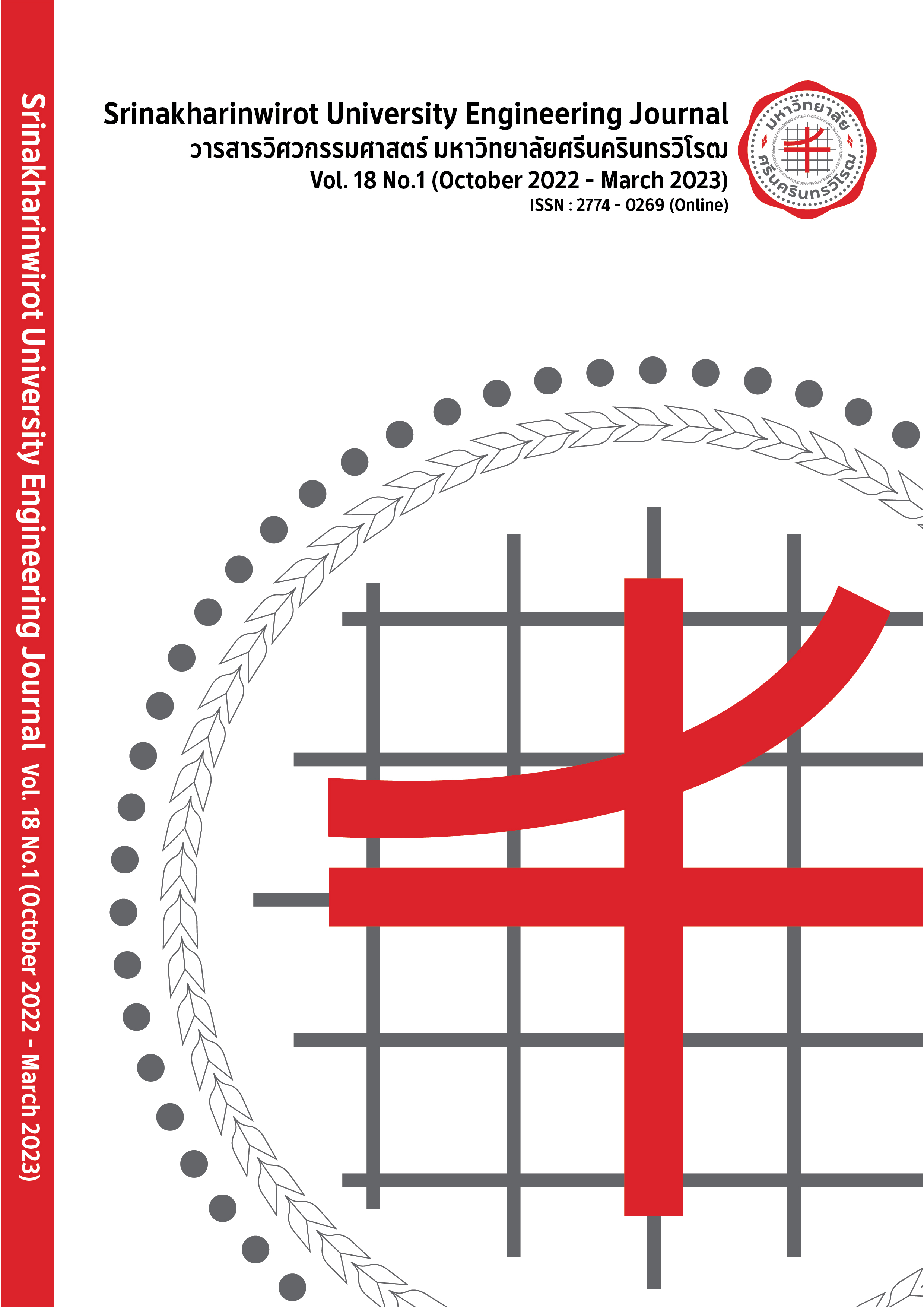Development of Salinity Intrusion Monitoring System for Durian Growing areas in Nonthaburi Province
Main Article Content
Abstract
This research is to develop a prototype of a salinity intrusion monitoring system using fuzzy logic to extract salinity values. A system is developed according to a fuzzy logic model using FAO's for appropriate agricultural water quality data, considering the Electrical Conductivity (EC) and total dissolved solids (TDS) as indicators of the salinity value by using the Fuzzy Logic Toolbox to produce and test the generated model. Transformation of the generated models to Embedded C format using the Simulink Coder tool installed in the Arm Cortex-M4 microcontroller and a 10-fold cross-validation test was used to validate the data extraction. The Root Mean Square Error (RMSE) for the test results was 0.58175 on average. This research result indicates that the generated model is able to extract data that very closely matches the specified data.
Article Details

This work is licensed under a Creative Commons Attribution-NonCommercial-NoDerivatives 4.0 International License.
Copyright belongs to Srinakharinwirot University Engineering Journal
References
S. Damrongsiri, “Drink Water How saliy?,” Environmental. vol. 25, no. 1, pp. 1-4, 2021.
ThaiPBS NEWS (2015, June 21). Seawater supports the duriannon orchard [Online]. Available: https://news.thaipbs.or.th/content /2901.
R.S. Ayers and D.W. Westcott, “Water quality for agricul-ture,” F.A.O. Irrigation and Drainage Paper No. 29 Rev. 1 FAO Rome, 1985.
L.E. Allison et al., “Diagnosis Improvement of Saline and Alkali Soils,” Agriculture Handbook No. 60, United States Department of Agriculture, Feb 1954.
B.C. Sarker and M.W. Zaman, “Extent of Pollution Assessment in Drinking Water Supplies of Narayanganj District in Bangladesh,” Journal of Biological Sciences, vol. 3, no. 10, pp. 854-863, 2003.
K.L. Priya, and G.P. Arulraj, “A correlation-regression model for the physiochemical parameters of the groundwater in Coimbatore city, India,” Environmental Technology, vol 32, no. 8, pp. 731-738, 2011.
C.M. Laluraj, and G. Gopinath, “Assessment on seasonal variation of groundwater quality of Phreatic aquifers – A river basin system,” Environmental Monitoring and Assessment, vol. 117, pp. 45-57, 2006.
K.L. Priya, “A Fuzzy Logic Approach for Irrigation Water Quality Assessment: A Case Study of Karunya Watershed, India,” J Hydrogeol Hydrol Eng, vol. 2, no. 1, Feb 2013.
S. Abdi, A.T. Pour, H. Shirani, M. Hamidpour and H. Shekofteh, “Assessing salinity and sodicity hazards of ground water for irrigation purposes using fuzzy logic,” Desalination Water Treatment, vol. 57, no. 33, pp. 15547-15558, Jul. 2016.
A.S. Nasr, M. Rezaei, and M.D. Barmaki, “Analysis of Groundwater Quality using Mamdani Fuzzy Inference System (MFIS) in Yazd Province, Iran,” International Journal of Computer Applications, vol.59, no. 7, pp. 45-53, Dec 2012.
F.M McNeill and E. Thro, Fuzzy Logic: A Practical Approach. Morgan Kaufmann Pub, 1994.
A. Chimnoi, (2015, Dec). Lessons from the saltwater crisis [Online]. Available: https:// www.duriannon.com/15559269
Water Quality Management Division, “Weekly water quality situation report,” Pollution control department, Mar. 25, 2013.
K. Kaewkamol, W. Chearboon, O. Thepsilpwisuit, D. Athinuwat, and B. Cherdhirunkorn, “Effect of Salinity Stress on Changing of Soil Properties and Falling Leaves of Durian cv. Kan Yao,” Thai Journal of Science and Technology, vol. 9, no. 1, Jan - Feb., pp. 68-67, 2020.
L. Zadeh, “Fuzzy algorithms,” Information and Control, vol. 12, no. 2, pp. 94–102, Feb 1968.
P. Meesad, Fuzzy Systems and Neural Network. 1th ed., KMUTNB Textbook Publishing Center, 2012.
D. Dubois and H. Prade, “What Are Fuzzy Rules and How to Use Them,” Fuzzy Sets and Systems, vol. 84, no. 2, pp. 169-185, Dec 1996.
M. F. Azeem (Ed.) Fuzzy Inference System - Theory and Applications. London, United Kingdom, IntechOpen, 2012 [Online]. Available:https://www.intechopen.com/books/1918
Yigang Shi and P. C. Sen, “A new defuzzification method for fuzzy control of power converters,” in Conference Record of the 2000 IEEE Industry Applications Conference. Thirty-Fifth IAS Annual Meeting and World Conference on Industrial Applications of Electrical Energy (Cat. No.00CH37129), 2000, pp. 1202-1209.
A.F. Rusydi, “Correlation between conductivity and total dissolved solid in various type of water: A review”, IOP Conference Series: Earth and Environmental Science, vol. 118, Feb, 2018.
Terrie K. Boguski, P.E., “Understanding Units of Measurement,” Center for Hazadous Substance Reseach, no. 2, Oct, 2006.
C. Chavez (2021, Feb. 25). Salt Concentration in the Soil,” United States Department of Agriculture Natural Resources Conservation Service. Nd. [Online]. Available: https://www. nrcs.usda.gov/Internet/FSE_DOCUMENTS/nrcs144p2_066452.pdf
USA: The MathWorks, Inc. (1994-2021). Fuzzy Logic Toolbox [Online]. Available: https:// www.mathworks.com/products/fuzzy-logic. html
USA: The MathWorks, Inc. (1994-2021). MATLAB [Online]. Available: https://www. mathworks.com
USA: The MathWorks, Inc. (1994-2021). Simulink coder [Online]. Available: https://www.mathworks.com/products/simulink-coder.html
STMicroelectronics, “Arm® Cortex®-M4 32-bit MCU+FPU,” STM34F401 datasheet, Jan. 2015 [Revised 3].
Thailand: Metropolitan Waterworks Authority (2014). Real Time Water Quality Surveillance System Project of the Metropolitan Waterworks Authority [Online]. Available: http://rwc.mwa.co.th/page/home.
T. Gunasegaran and Y. Cheah, “Evolutionary cross validation,” in 8th International Conference on Information Technology (ICIT), 2017, pp. 89-95.


